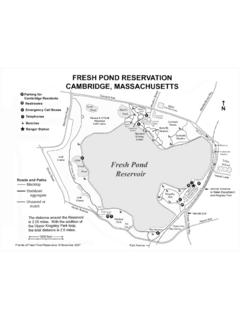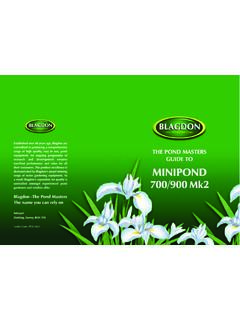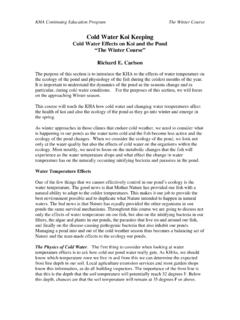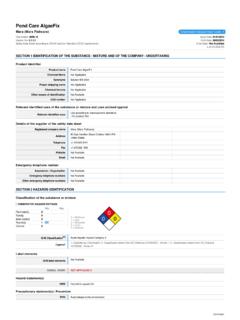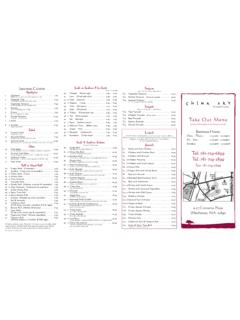Transcription of Identifying Aquatic Insects From Your Pond
1 Penobscot County Soil & Water Conservation District Natural Resources Conservation Service 28 Gilman Plaza, Suite #2 Bangor, ME 04401 Tel: (207) 990-3676 Fax: (207) 942-1782 Identifying Aquatic Insects From Your Pond Identifying Aquatic Insects From Your Pond The following Aquatic Insects include some of those that you might encounter when exploring your pond. This guide is intended to help you identify these Insects and to learn some interesting characteristics about each. Mayfly (Order: Ephemeroptera) Habitat of Nymph: Fresh running water of ponds and streams. Habitat of Adult: Short lived flying insect that mates and then dies. Characteristics: Distinguished from other nymphs by seven pairs of gills along the abdomen.
2 Oxygen is absorbed from water. Nymphs generally have three tails attached to the end of the abdomen. Wing pads are visible on the nymph. Nymphs feed on live and decaying vegetation. Nymphs are a common food source for trout and other fish. Mayfly nymphs require 4 to 10 ppm of dissolved oxygen for survival. Nymphs are up to cm long. They have three pairs of segmented legs with one claw at the end of each leg. Dragonfly (Order: Odonata) Habitat of Nymph: ponds marshes and slow moving streams. Habitat of Adult: Fast flying insect. Characteristics: Distinguished by large compound eyes with nearly 360-degree vision in both the nymph and adult stage. Nymphs have "lips" hinged in two places with grasping pincers on the end for catching prey.
3 Brown and green bodies tend to provide camouflage and allow the nymph to blend in with the Aquatic habitat of plants and pond bottoms. Gills inside the abdomen obtain oxygen. Water drawn into the abdomen and through the gills is expelled to propel the nymph through the water. Dragonfly nymphs require 4 to 8 ppm of dissolved oxygen for survival. They have three pairs of segmented legs on upper part (thorax) of body. Dragonfly larvae can be distinguished from damselfly larvae by a wide to oval abdomen that may end in wedge shaped extensions. Nymphs are predators and feed on mollusks, other Insects , crustaceans, worms, and small fish. Nymphs are a food source for some fish. Damselfly (Order: Odonata; Suborder: Zygoptera) Habitat of Nymph: ponds , marshes, and slow moving streams.
4 Habitat of Adult: Fast flying insect. Characteristics: In the same order as dragonflies and similar to dragonflies but generally smaller and more delicate. Distinguished by large compound eyes with nearly 360-degree vision in both the nymph and adult stage. Nymphs have "lips" hinged in two places with grasping pincers on the end for catching prey. Brown and green bodies tend to provide camouflage and allow the nymph to blend in with the Aquatic habitat of plants and pond bottoms. Three leaf-like gills at the base of the abdomen obtain oxygen. Damselfly nymphs require 4 to 8 ppm of dissolved oxygen for survival. Damselfly nymphs can be distinguished from dragonfly nymphs by a narrow body with three gills extending in a tripod formation at the end of body.
5 The three pairs of legs are long and spindly. Nymphs are predators and feed on mollusks, other Insects , crustaceans, worms, and small fish. Nymphs are a food source for some fish. Stonefly (Order: Plecoptera) Habitat of Nymph: Cold lakes or fast moving streams. Habitat of Adult: Flying insect. Characteristics: Distinguished by obvious wing pads on nymph and two tails that remain on the adult. They also do not have leaf like gills along both sides of the abdomen as the mayfly does. Oxygen is obtained by single gills under the legs or through the skin surface. Stonefly nymphs require 8 to 10 ppm of dissolved oxygen for survival. They have two long antennae much longer than the head.
6 They have three pairs of segmented legs that end in small hooks. The nymph appears to be flattened in shape for crawling along and under stones. Nymphs feed on decaying plants and animals or other small macroinvertebrates. Nymphs are a food source for some fish. Water Strider (Order: Hemiptera) Habitat of Nymph: ponds and slow moving streams. Habitat of Adult: ponds and slow moving streams. Characteristics: Water striders appear to skate across the water surface. Their legs can pick up vibrations of other organisms. Oxygen is absorbed by spiracles or specialized holes in their skin surface. Giant Water Bug (Order: Hemiptera; Family: Belostomatidae) Habitat of Nymph: ponds and slow moving streams.
7 Habitat of Adult: ponds and slow moving streams. Characteristics: The Giant Water Bug gets oxygen through a snorkel like breathing tube that extends to the water surface. They have three pairs of jointed legs. The front pair has a modified hook for catching and holding prey. Giant Water Bugs may be up to 8 cm in size. True predators in the Aquatic environment, Giant Water Bugs will attack prey that are 20 times larger in size. Water Scorpion (Order: Hemiptera; Family: Nepidae) Habitat of Nymph: ponds and slow moving streams. Habitat of Adult: ponds and slow moving streams. Characteristics: Water Scorpions get oxygen through long breathing tubes at the base of the abdomen. They look more like sticks than like Insects .
8 They are up to 10 cm in length. They have three pairs of jointed legs. The front pair has a set of single hooks for capturing and holding prey. Water Boatman (Order: Hemiptera) Habitat of Nymph: ponds , running water of streams and intertidal marshes. Habitat of Adult: ponds , running water of streams and intertidal marshes. Characteristics: Water Boatmen have middle and hind legs covered with long swimming hairs. They eat decaying matter as well as other animals. Because they rely on atmospheric oxygen many species are tolerant of pollution and can live in oxygen-poor environments. Atmospheric oxygen is trapped as an air bubble (or plastron) beneath microscopic hairs. Backswimmer (Order: Hemiptera) Habitat of Nymph: ponds , running water of streams and intertidal marshes.
9 Habitat of Adult: ponds , running water of streams and intertidal marshes. Characteristics: Backswimmers have middle and hind legs covered with long swimming hairs like water boatman but swim on their back. Mosquito (Order: Diptera) Habitat of Larvae: Generally ponds , marshes, lakes and slow moving steams some species have adapted to fast moving streams. Habitat of Adult: Small flying insect. Characteristics: Larvae have a small siphon or snorkel tube to acquire oxygen from the air. They can tolerate waters with very low levels of dissolved oxygen. Mosquito larvae can tolerate levels of dissolved oxygen of less than 4 ppm. Larvae are a food source for fish. Cranefly (Order: Diptera; Family: Tipulidae) Habitat of Larvae: ponds , lakes, and marshes.
10 Habitat of Adult: Flying insect. Characteristics: Larvae are plump, long, and cylindrical. Larvae may be up to 10 cm in length. At the end of the abdomen are spiracles or breathing holes that look like fingers. The larvae will move to the water surface to breathe oxygen from the air. The abdomen of some species is flattened. The back end usually has several small extensions or lobes. Often the small head is not visible and is hidden within the first segment of the body. Larvae are a food source for fish. Midges (Order: Diptera; Family: Chironomidae) Habitat of Larvae: Bottom sediments of lakes, ponds , or streams. Habitat of Adult: Small flying insect. Characteristics: Larvae are up to cm in length.
